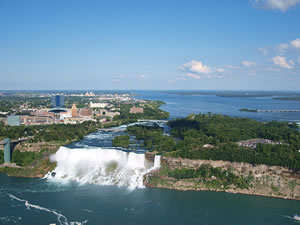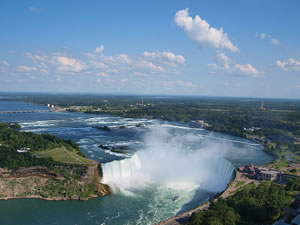Niagara Falls in North America is renowned for its beauty. The waters of the Niagara River are free of sediment and sand, and so Niagara Falls creates a permanent cloud of mist and pure white spray as it cascades downward.
In 1842, Charles Dickens wrote, after visiting Niagara Falls, "What voices spoke from out those thundering waters; what faces, faded from Earth, looked out upon me from its gleaming depths; what heavenly promise glistened in those angels' tears, the drops of many hues that showered around and twined themselves about the gorgeous arches which the changing rainbows make."
 Niagara Falls probably reached its present position almost 700 years ago when Goat Island separated it into two distinct cascades - the American Falls and Horseshoe Falls (the Canadian Falls).
Niagara Falls probably reached its present position almost 700 years ago when Goat Island separated it into two distinct cascades - the American Falls and Horseshoe Falls (the Canadian Falls).
The American Falls lie to the east of Goat Island. They are 56m (184ft) tall and 323m (1,060ft) across and carry less than 10 per cent of the Niagara River's water.
 The rest of the water hurtles over Canada's Horseshoe Falls. These horseshoe-shaped falls are 54m (176ft) tall and 675m (2,215ft) across.
The rest of the water hurtles over Canada's Horseshoe Falls. These horseshoe-shaped falls are 54m (176ft) tall and 675m (2,215ft) across.
Because the river is deeper on the Canadian side, erosion is faster. As a result, the Horseshoe Falls have retreated an estimated 300m (1,000ft) in 300 years.
Formation of Niagara Falls
Until around 10,000 years ago, enormous glaciers that covered much of North America forced the waters of the Great Lakes to flow south to the Mississippi River.
When the glaciers melted at the end of the ice age, the Niagara River was formed. It drained the waters of Lakes Superior, Huron and Michigan, via Lake Erie, across a small plateau and over a steep escarpment into the basin of Lake Ontario.
The Niagara plateau is made up of several horizontal layers of different rocks. At the bottom is a thick bed of shale that is overlaid by sandstone.
Both of these rocks are comparatively soft and therefore easily eroded.
Above them lies dolomite. This is an extremely hard and weather-resistant type of limestone. The turbulence created at the foot of the falls quickly erodes the shale and sandstone, leaving a dolomite overhang.
This has created a vertical drop over which the Niagara River plunges.
When the weight of unsupported dolomite is great enough, the overhang collapses and falls down as huge boulders to the bottom of the escarpment. This constant undercutting, which began when the Niagara River was formed, has moved the falls about 11km (7mi) upstream from their original position.